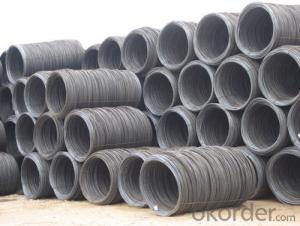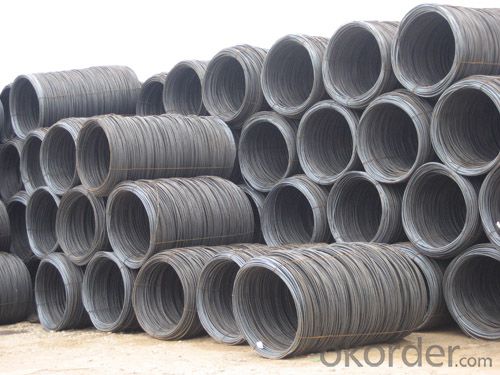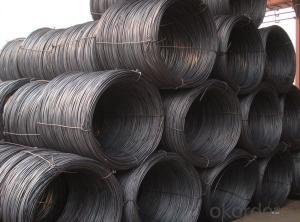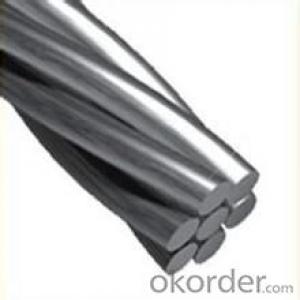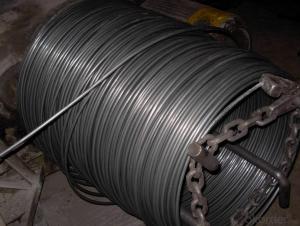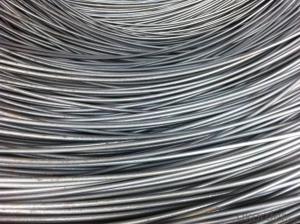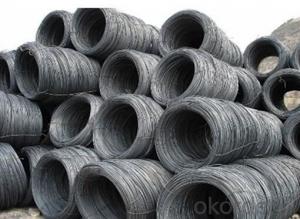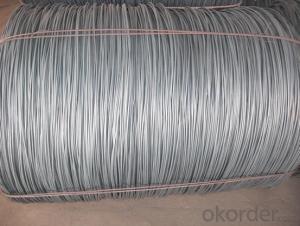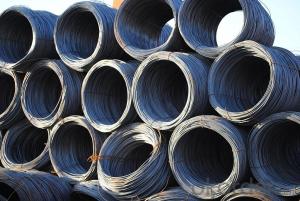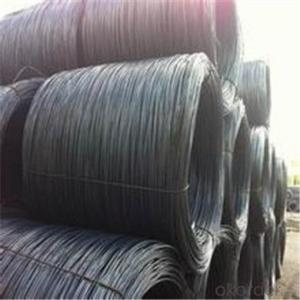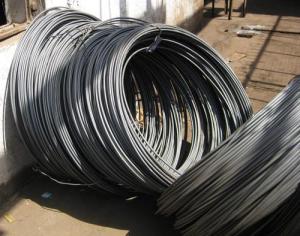GB Standard Steel Wire Rod with High Quality 7mm-8mm
- Loading Port:
- China Main Port
- Payment Terms:
- TT or LC
- Min Order Qty:
- 40 m.t
- Supply Capability:
- 15000 m.t/month
OKorder Service Pledge
OKorder Financial Service
You Might Also Like
Product Description:
Specifications of GB Standard Steel Wire Rod with High Quality 7mm-8mm:
Steel Grade: Q195 Standard: GB
Diameter: 7mm, 8mm
6.5mm can be drawing into 2mm/8.0mm can be drawing into 3mm
Each coil weight about 2MT
Chemical Composition:
Please kindly find our chemistry of our material based on Q195 as below for your information
Trademark | Rank | Chemical composition (quality score) % | |||||
C | Si | Mn | S | P | |||
| ≤ |
| ≤ | ≤ | |||
Q195 |
| 0.06-0.12 | 0.30 | 0.25 | 0.050 | 0.045 | |
Trademark | Rank | Pulling Test | |||||
Bend PointΔs/Mpa | Tensile Strength | Elongation Ratioδ5% | |||||
Thickness (Diameter) /MM | Thickness (Diameter) /MM | ||||||
≤16 | 16-40 | ≤16 | 16-40 | ||||
≥ | ≥ | ||||||
Q195 |
| 195 | 185 | 315-390 | 33 | 32 | |
Usage and Applications of GB Standard Steel Wire Rod with High Quality 7mm-8mm:
After hot-rolled the products shaped into coil and delivery as finished product, including round, square, rectangular, hexagonal and so on. Since most of the products are round, it is generally called wire rod. Carbon steel wire rod is widely used in construction and manufacturing. Carbon steel wire rod is mainly used for reinforcement of reinforced concrete and welded structure or reprocessed (roberts , nail, etc.) materials, especially used to produce wire drawing, welding electrode, nails, spring, electronic, precise machinery parts and so on.
Production Process of GB Standard Steel Wire Rod with High Quality 7mm-8mm:
Steel billet---Heating---Rolling---Water-cooling---Coiling---Cooling---Inspection---Bundling---Exworks
Packaging & Delivery of GB Standard Steel Wire Rod with High Quality 7mm-8mm:
Packaging Detail: products are packed in coil and then shipped by container or bulk vessel
Each coil weight: About 2MT
Delivery Detail: within 45 days after received deposit or LC.
Label: to be specified by customer, generally, each bundle has 1-2 labels
Trade terms: FOB, CFR, CIF
FAQ:
Q1: How soon can we receive the product after purchasement?
A1: Within three days of placing an order, we will begin production. The specific shipping date is dependent upon international and government factors, but is typically one month.
Q2: How do you guarantee the quality of our products?
A2: We have established an advanced quality management system which conducts strict quality tests at every step, from raw materials to the final product. At the same time, we provide extensive follow-up service assurances as required.
Q3: The prices are invoicing on theoritical weight or on actual weight?
A3: We can do it in both manners, according to the customers' request.
Images of GB Standard Steel Wire Rod with High Quality 7mm-8mm:
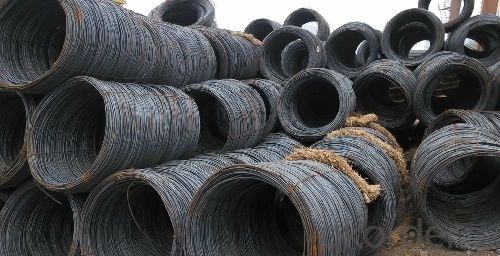
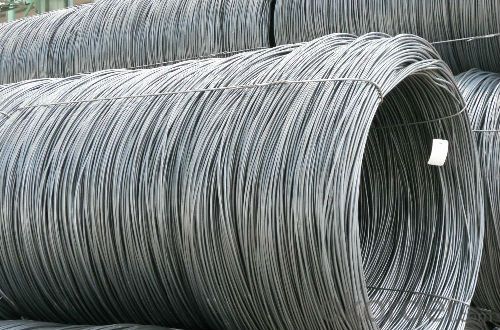
*If you would like to get our price, please kindly inform us the size, standard/material and quantity. Thank you very much for your attention.
- Q: How is steel wire rod used in the production of conveyor belts?
- Steel wire rod is used in the production of conveyor belts as the main reinforcement component. It is typically formed into a spiral or helix shape and embedded in the rubber or plastic material of the belt. This reinforcement provides strength and durability to the conveyor belt, allowing it to withstand heavy loads and continuous movement. Additionally, the steel wire rod enhances the flexibility and stability of the belt, ensuring smooth and efficient transportation of materials.
- Q: What are the properties of steel wire rod?
- Steel wire rods have several properties that make them useful in various applications. Firstly, they have high strength and durability, allowing them to withstand heavy loads and resist deformation. Additionally, they have excellent ductility, meaning they can be easily shaped and bent without breaking. Steel wire rods also exhibit good thermal conductivity and electrical conductivity, making them suitable for use in heating elements and electrical wires. They have a high melting point, ensuring their stability at high temperatures. Furthermore, steel wire rods have corrosion resistance, making them suitable for outdoor and marine applications. Overall, the properties of steel wire rods make them versatile and widely used in industries such as construction, automotive, and manufacturing.
- Q: What are the different types of steel wire rod available in the market?
- There are several different types of steel wire rod available in the market, including carbon steel wire rod, low-alloy steel wire rod, stainless steel wire rod, and galvanized steel wire rod. Each type has its own unique properties and applications, making them suitable for various industries such as construction, automotive, and manufacturing.
- Q: What are the standard cleanliness requirements for steel wire rod?
- The standard cleanliness requirements for steel wire rod typically include the absence of surface defects such as scale, rust, or pitting. It should also be free from any contaminants like dirt, oil, or grease. Additionally, the wire rod should meet specific chemical composition and mechanical properties as per industry standards or customer specifications.
- Q: What is the annealing process for steel wire rod?
- The annealing process for steel wire rod involves heating the material to a specific temperature and then slowly cooling it down to enhance its ductility, eliminate internal stresses, and improve its mechanical properties. This process helps in reducing brittleness, improving workability, and achieving the desired hardness and strength levels for the steel wire rod.
- Q: What are the different grades of steel wire rod?
- The different grades of steel wire rod include low carbon, medium carbon, high carbon, and alloy steel wire rods.
- Q: How is steel wire rod used in the manufacturing of wire forms for automotive components?
- Steel wire rod is an essential component in the manufacturing of wire forms for automotive components. Wire forms are intricate shapes and designs made from metal wire, and they play a crucial role in various automotive applications such as springs, clips, brackets, and fasteners. The process begins with steel wire rods, which are typically made from carbon or alloy steel. These rods serve as the raw material for wire drawing, which is the primary method used to produce wire forms. Wire drawing involves pulling the steel wire rod through a series of dies to reduce its diameter and increase its length. This process helps to improve the wire's tensile strength and surface finish, making it suitable for automotive applications. Once the desired wire diameter is achieved through wire drawing, it is then fed into specialized machinery to create different wire forms. This machinery includes automated CNC (Computer Numerical Control) machines that can bend, shape, and cut the wire according to precise specifications. These machines use different tools and dies to form wire into the desired shape, ensuring accuracy and consistency. Wire forms manufactured from steel wire rod offer several advantages for automotive components. Firstly, steel wire rods provide excellent strength and durability, making them suitable for handling the demanding conditions within automotive systems. They can withstand high temperatures, vibrations, and mechanical stresses, ensuring the wire forms maintain their structural integrity over time. Moreover, steel wire rods offer flexibility in terms of design and customization. Manufacturers can easily create wire forms of various sizes, shapes, and configurations to meet the specific requirements of different automotive components. This versatility allows for the production of wire forms that are tailored to fit the precise needs of the automotive industry, enhancing the overall performance and functionality of the components. Additionally, steel wire rods are cost-effective and readily available, making them a preferred choice for wire form manufacturing in the automotive sector. The abundance of steel as a raw material ensures a stable supply chain, allowing manufacturers to meet the high demands of the automotive industry efficiently. In conclusion, steel wire rod is a crucial component in the manufacturing of wire forms for automotive components. Through the process of wire drawing and specialized machinery, steel wire rods are transformed into intricate shapes and designs that provide strength, durability, and flexibility. This enables the production of wire forms that meet the stringent requirements of automotive applications, ultimately contributing to the overall functionality and performance of automotive components.
- Q: How are steel wire rods used in the production of screws and bolts for construction?
- Steel wire rods are an essential component in the production of screws and bolts for construction purposes. These rods serve as the raw material for manufacturing these fasteners. To begin with, steel wire rods are first processed through a series of manufacturing steps. They are initially drawn through a series of dies to reduce their diameter and increase their length. This process is known as wire drawing, and it helps in achieving the desired size and strength of the wire rod. Once the wire rods are drawn to the required dimensions, they are then cut into smaller lengths that are suitable for the production of screws and bolts. These lengths are often referred to as blanks or billets. The next step involves the threading of these blanks to create the screw or bolt shape. This threading process is typically done using specialized machines that cut or roll grooves onto the surface of the wire rods. These grooves are what enable the screws and bolts to effectively grip into their respective materials, providing a secure connection. After the threading process, the blanks are further processed to add various features, such as the head shape, drive type (such as slotted, Phillips, or hex), and any additional coatings or finishes required for corrosion resistance. This is typically done through machining or forging processes, depending on the desired specifications of the screws and bolts. Once the screws and bolts are formed, they undergo quality control checks to ensure that they meet the necessary standards for strength, dimensions, and overall functionality. This includes testing for factors like tensile strength, hardness, and dimensional accuracy. Finally, the screws and bolts are packaged and distributed for use in construction projects. These fasteners play a crucial role in joining various components of a structure together, providing stability, strength, and longevity to the overall construction. They are widely used in applications such as framing, fastening walls, securing beams, and connecting various building materials. In summary, steel wire rods are used in the production of screws and bolts for construction by serving as the raw material that is processed, threaded, and shaped into fasteners with specific features and properties. These fasteners are vital for the structural integrity and reliability of construction projects, making steel wire rods a crucial component in the construction industry.
- Q: What are the different types of steel wire rod surface defect classification systems?
- There are several different types of steel wire rod surface defect classification systems, including the ISO 16120-3 classification system, the ASTM A510M classification system, and the JIS G 3505 classification system. These classification systems provide standardized terms and definitions for various types of surface defects found on steel wire rods, helping to identify and categorize any imperfections or abnormalities in the material.
- Q: How is steel wire rod used in the production of wire mesh screens?
- Steel wire rod is a crucial component in the production of wire mesh screens. Wire mesh screens are widely used in various industries, such as construction, mining, agriculture, and manufacturing, for their durability and versatility. The steel wire rod is the starting material for manufacturing wire mesh screens. It is typically made from low carbon steel and undergoes a series of processes to transform it into the final product. First, the steel wire rod is drawn through a series of dies to reduce its diameter and increase its length. This process, known as wire drawing, results in long continuous strands of thin steel wire. These wire strands are then further processed through a series of machines to give them the required shape and dimensions. The wire is woven or welded together to form a grid-like pattern, creating the wire mesh screen. The wire mesh screens can be customized with different opening sizes, wire diameters, and weaving patterns to meet specific application requirements. For instance, screens used in construction applications may have larger openings to allow for better airflow, while screens used in mining may have smaller openings to filter out particles of specific sizes. The steel wire rod used in the production of wire mesh screens ensures the screens are strong and durable. Steel is known for its high tensile strength, which makes the screens capable of withstanding heavy loads, impacts, and harsh environmental conditions. Additionally, steel wire rod provides excellent corrosion resistance, which is crucial for wire mesh screens used in outdoor applications or industries where exposure to moisture, chemicals, or other corrosive substances is common. In conclusion, steel wire rod plays a vital role in the production of wire mesh screens by providing the necessary strength, durability, and corrosion resistance. These screens are widely used in various industries for their versatility and ability to meet specific application requirements.
Send your message to us
GB Standard Steel Wire Rod with High Quality 7mm-8mm
- Loading Port:
- China Main Port
- Payment Terms:
- TT or LC
- Min Order Qty:
- 40 m.t
- Supply Capability:
- 15000 m.t/month
OKorder Service Pledge
OKorder Financial Service
Similar products
Hot products
Hot Searches
Related keywords
